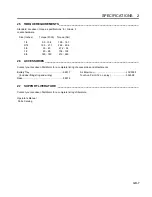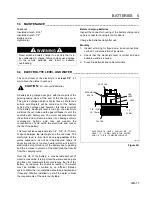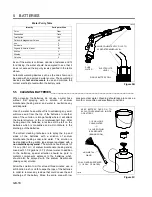
5 BATTERIES
GB-20
5.8
TROUBLESHOOTING _______________________________________________________
In general, troubleshooting will be done for two distinct
reasons. First, a battery that performs poorly and outside
of the manufacturers specification should be identified in
order to replace it under the terms of the manufacturer’s
warranty. Different manufacturers have different
requirements. Consult with the battery manufacturer for
specific requirements.
The second reason is to determine why the tractor does
not perform adequately. Performance problems may
result in a tractor that runs slowly or in a tractor that is
unable to operate as long as it previously did.
A new battery must mature before it will develop its
maximum capacity. Maturing may take up to 100 charge/
discharge cycles. The older a battery gets, the lower the
capacity. The only way to determine the capacity of a
battery is to perform a load test using a discharged
machine.
A cost effective way to identify a poorly performing
battery is to use a hydrometer to identify a battery in a set
with a lower than normal specific gravity. Once the
particular cell or cells that are the problem are identified,
the suspect battery can be removed and replaced. At this
point there is nothing that can be done to salvage the
battery; however, the individual battery should be
replaced with one of the same brand, type and
approximate age that is known to be good.
5.9
HYDROMETER ____________________________________________________________
Hydrometers are used to test the state of charge of a
battery cell. This is performed by measuring the density
of the electrolyte, which is accomplished by measuring
the specific gravity of the electrolyte. The greater the
concentration of sulfuric acid, the more dense the
electrolyte becomes. The higher the density, the higher
the state of charge.
Specific gravity is the measurement of a liquid that is
compared to a baseline. The baseline is water which is
assigned a base number of 1.000.
The concentration of sulfuric acid to water in a new
battery is 1.280 which means that the electrolyte weighs
1.280 times the weight of the same volume of water.
A fully charged battery will test at 1.275 - 1.280 while a
discharged battery will read in the 1.140 range.
Note: Do not perform a hydrometer test on a battery that
has just been watered. The battery must go through at
least one charge and discharge cycle in order to permit
the water to adequately mix with the electrolyte.
The temperature of the electrolyte is important since the
hydrometer reading must be corrected to 80
°
F (26.7
°
C).
High quality hydrometers are equipped with an internal
thermometer that will measure the temperature of the
electrolyte and will include a conversion scale to correct
the float reading. It is important to recognize that the
electrolyte temperature is significantly different from the
ambient temperature if the vehicle has been operated.
Using a Hydrometer (Figure 5E)
1.
Draw electrolyte into the hydrometer several times to
permit the thermometer to adjust to the electrolyte
temperature and note the reading. Examine the color
of the electrolyte. A brown or gray coloration indi-
cates a problem with the battery and is a sign that the
battery is nearing the end of its life.
2.
Draw the minimum quantity of electrolyte into the
hydrometer to permit the float (B) to float freely
without contacting the top or bottom of the cylinder
(E).
3.
Hold the hydrometer in a vertical position at eye
level and note the reading where the electrolyte
meets the scale on the float.
4.
Add or subtract four points (.004) to the reading for
every 10
°
F (6
°
C) above or below 80
°
F (27
°
C).
See Examples 1 and 2. Adjust the reading to
conform with the electrolyte temperature.
5.
E.g. If the reading indicates a specific gravity of
1.250 and the electrolyte temperature is 90
°
F (32
°
C), add four points to the 1.250 which gives a
corrected reading of 1.254. Similarly if the
temperature was 70
°
F (21
°
C), subtract four points
from the 1.250 to give a corrected reading of 1.246.
WARNING
Never insert a metal thermometer into a battery. Use a
hydrometer with a built in thermometer that is
designed for testing batteries.
!
!
















































